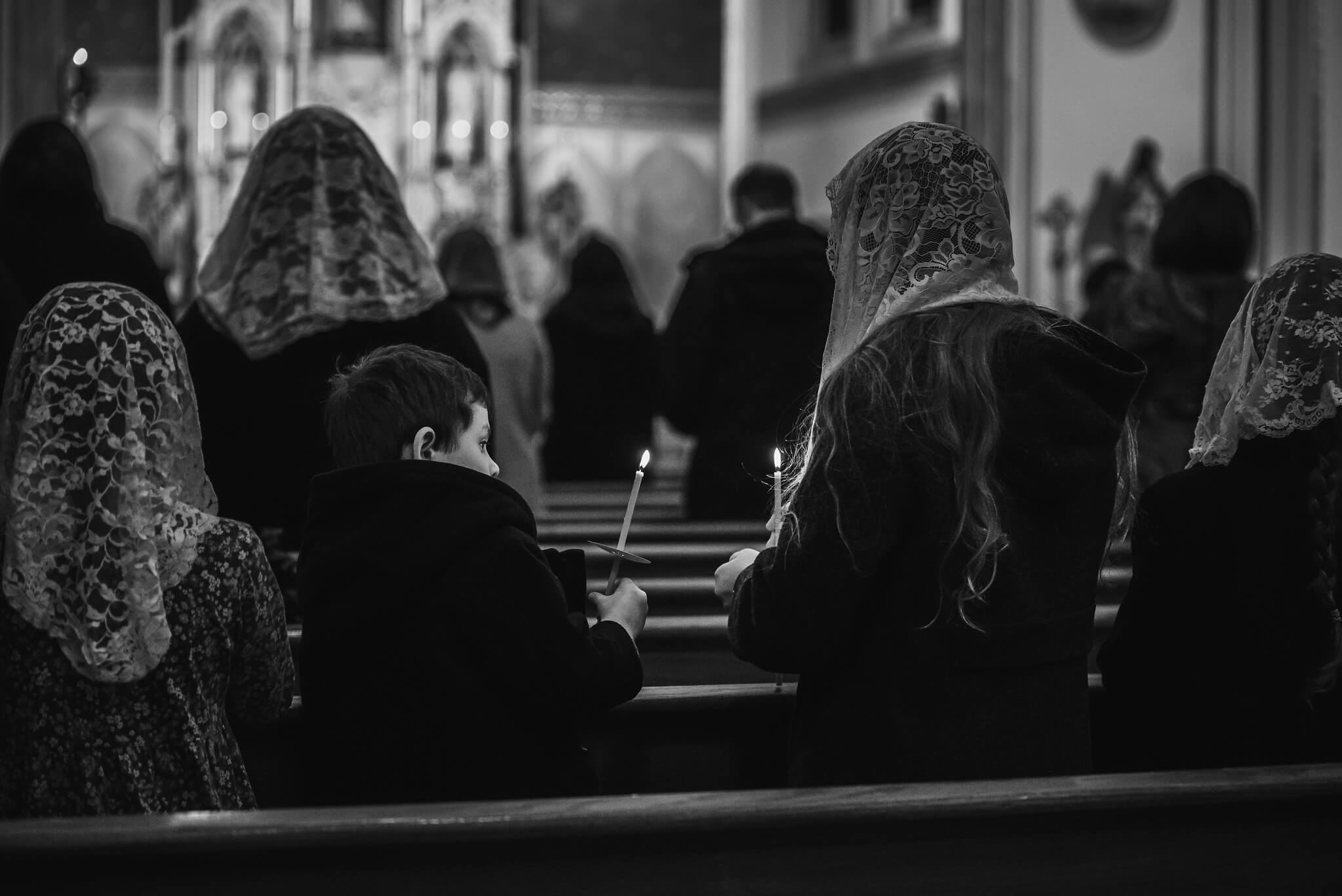Candlemas, as it’s called, is a twofold feast of the Presentation of Our Lord and the Purification of Our Lady, and it marks the end of the forty days of the Christmas season. It is primarily a Marian feast commemorating the obedience of Our Lady and Our Lord to the law of Moses. The name Candlemas refers to the candles blessed and distributed before Mass. The traditions of this feast are profoundly symbolic and beautiful.
“Lumen ad revelationem gentium: et Gloriam plebis tuae Israel.”
This is the antiphon sung at the beginning and during the distribution of candles on Candlemas, taken from the words of the Prophet Simeon: “A light to the revelation of the Gentiles, and the glory of Thy people Israel.”
The Prophet speaks of the Christ-child, brought by St. Joseph and the Blessed Virgin to be presented at the temple in accordance with the law. The prayers of Candlemas continue with yet another joyous and jubilant antiphon:
O Sion, adorn thy bridal chamber, and welcome Christ the King: embrace Mary, for she who is the very gate of heaven, brings to Thee the glorious King of the new light. Remaining ever Virgin, in her arms she bears her Son begotten before the day-star, whom Simeon, receiving into his arms declared unto all peoples to be the Lord of life and of death and the Savior of the world.
Mary was conceived without original sin, and nothing she ever did, at any point in her life, blemished her soul. She was further sanctified by the child in her womb, the Christ, who was God made man. It was therefore not necessary for Mary to wait the forty days of purification, as she had never been stained. In accordance with the Law of Moses, she nevertheless went. Christ, King of kings and Lord over all the earth, similarly made Himself subject to His mother and foster-father and the Law of Moses. He was neither a revolutionary nor a rebel, and He gave the respect due to properly established temporal rulers. He complied with the old Law when He Himself was the New Law. He made Himself subject to His parents, who were mere creatures. He answered the high priest and Pilate during His Passion, even though Christ Himself was the ultimate High Priest, and Pilate’s authority had no power over Him.
Jacob de Voragine‘s The Golden Legend, written near the end of the 13th century, contains a story of the first Candlemas. A noble lady with a great devotion to Our Lady was once left without Mass on the feast of the Purification. Saddened by this, she went into her private chapel to pray. Soon she fell asleep, and she then had a vision that she was alone in a magnificent church. A noble virgin queen leading a large company of virgins entered, and soon after, a company of young men filed into the church. A single man entered bearing candles and gave one to everyone, including the lady who was receiving the vision. Christ, vested as a priest, and Saints Lawrence and Vincent, vested as deacon and subdeacon, together went up to the altar to say Mass. Two angels bore candles before them. Another two angels began the Introit, and the company of virgins sang the Mass. At the Offertory, the woman saw the glorious queen, followed by the other virgins and young men, approach the altar and kneel devoutly, where she offered her candle to the priest. The other virgins and young men also knelt and presented their candles to Christ.
Despite seeing this reverent gesture of the heavenly congregation, the noble lady did not come forward. Some time passed as the priest waited for the lady to come to offer her candle. At last, the queen of the virgins sent a messenger to the noble lady saying that it was not respectful to make the priest wait. The lady answered that the priest should proceed with his Mass, for she would keep her candle to herself. The glorious virgin queen sent another messenger to the lady, but she still said she would not offer her candle. At last the queen said to a third messenger, “Go and ask her to come and offer her candle, or else take it from her by force.” The messenger came to the lady, and because she still would not come and offer her candle, he set his hand on it and pulled hard. But the lady held fast, and he pulled so strongly that the candle broke in two pieces, with one half still in the hand of the noblewoman. At that moment, she awoke and found the piece of the candle still in her hand.
This story clearly illustrates the theme of obedience, which is universal in the prayers of Candlemas, the Purification, and the Presentation. Only those who practice perfect obedience and who sacrifice their lives to God are worthy to enter paradise. Mary, “the very gate of heaven,” and Jesus Christ, her Son, show us a perfect example of obedience in the way they submitted to the Law of Moses in the Presentation and Purification. We must be, as Christ was, obedient to those who legitimately exercise their authority over us, just as we must be obedient in all things to the Giver of all Authority. Yet like Christ and the Apostles, we might be faced with a situation where we must “obey God over man” (Acts 5:9) and suffer for it. The candles we bear at Candlemas symbolize our submission to Christ. Like Our Lord and the Blessed Virgin, may we practice perfect obedience to God and make a total sacrifice of our lives so that, one day, we might share in the glories of paradise.
Photo by Allison Girone. Used with permission.


